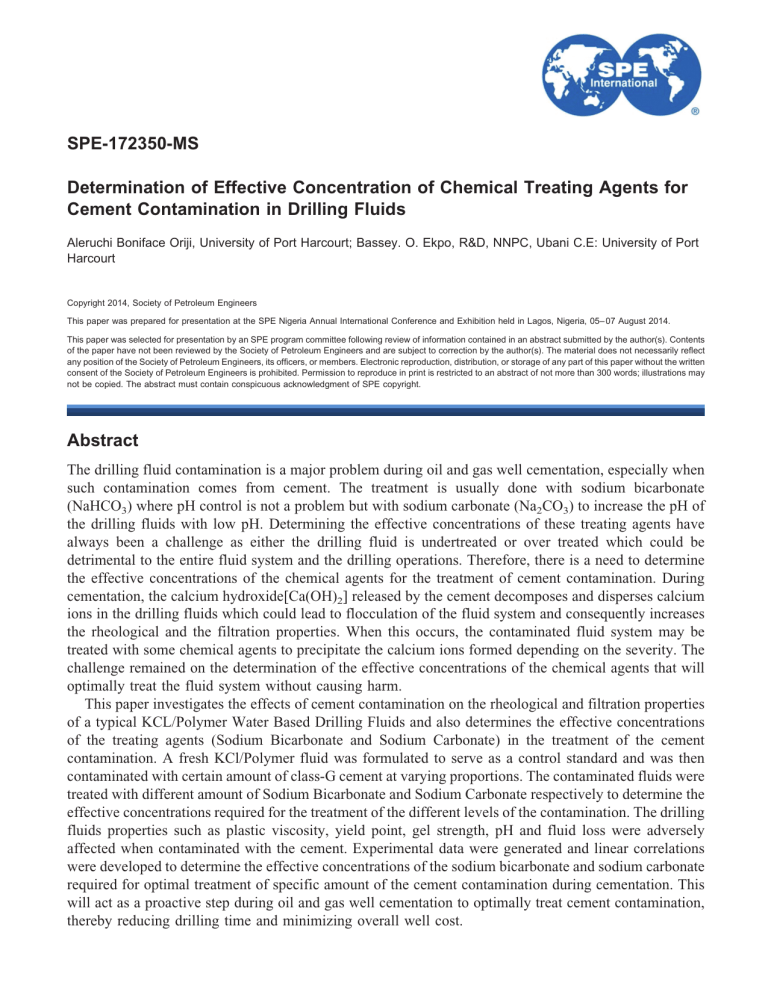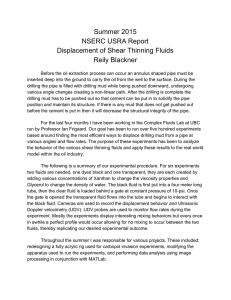
SPE-172350-MS Determination of Effective Concentration of Chemical Treating Agents for Cement Contamination in Drilling Fluids Aleruchi Boniface Oriji, University of Port Harcourt; Bassey. O. Ekpo, R&D, NNPC, Ubani C.E: University of Port Harcourt Copyright 2014, Society of Petroleum Engineers This paper was prepared for presentation at the SPE Nigeria Annual International Conference and Exhibition held in Lagos, Nigeria, 05– 07 August 2014. This paper was selected for presentation by an SPE program committee following review of information contained in an abstract submitted by the author(s). Contents of the paper have not been reviewed by the Society of Petroleum Engineers and are subject to correction by the author(s). The material does not necessarily reflect any position of the Society of Petroleum Engineers, its officers, or members. Electronic reproduction, distribution, or storage of any part of this paper without the written consent of the Society of Petroleum Engineers is prohibited. Permission to reproduce in print is restricted to an abstract of not more than 300 words; illustrations may not be copied. The abstract must contain conspicuous acknowledgment of SPE copyright. Abstract The drilling fluid contamination is a major problem during oil and gas well cementation, especially when such contamination comes from cement. The treatment is usually done with sodium bicarbonate (NaHCO3) where pH control is not a problem but with sodium carbonate (Na2CO3) to increase the pH of the drilling fluids with low pH. Determining the effective concentrations of these treating agents have always been a challenge as either the drilling fluid is undertreated or over treated which could be detrimental to the entire fluid system and the drilling operations. Therefore, there is a need to determine the effective concentrations of the chemical agents for the treatment of cement contamination. During cementation, the calcium hydroxide[Ca(OH)2] released by the cement decomposes and disperses calcium ions in the drilling fluids which could lead to flocculation of the fluid system and consequently increases the rheological and the filtration properties. When this occurs, the contaminated fluid system may be treated with some chemical agents to precipitate the calcium ions formed depending on the severity. The challenge remained on the determination of the effective concentrations of the chemical agents that will optimally treat the fluid system without causing harm. This paper investigates the effects of cement contamination on the rheological and filtration properties of a typical KCL/Polymer Water Based Drilling Fluids and also determines the effective concentrations of the treating agents (Sodium Bicarbonate and Sodium Carbonate) in the treatment of the cement contamination. A fresh KCl/Polymer fluid was formulated to serve as a control standard and was then contaminated with certain amount of class-G cement at varying proportions. The contaminated fluids were treated with different amount of Sodium Bicarbonate and Sodium Carbonate respectively to determine the effective concentrations required for the treatment of the different levels of the contamination. The drilling fluids properties such as plastic viscosity, yield point, gel strength, pH and fluid loss were adversely affected when contaminated with the cement. Experimental data were generated and linear correlations were developed to determine the effective concentrations of the sodium bicarbonate and sodium carbonate required for optimal treatment of specific amount of the cement contamination during cementation. This will act as a proactive step during oil and gas well cementation to optimally treat cement contamination, thereby reducing drilling time and minimizing overall well cost. 2 SPE-172350-MS Introduction Drilling fluid is related either directly or indirectly to almost every drilling problems. This is not to say that the drilling fluids is the cause or solution of all drilling problems but it is a major system that can often be used to alleviate a problematic situation during drilling.. A successful oil and gas drilling operation depends largely on the quality of the drilling fluids used. Hence accurate drilling fluids test and analysis are necessary for proper control of their properties and to detect changes in the composition of the fluid system. Contamination is one of the major problems facing drilling fluids during drilling operations. This is as a result of some physical and chemical contaminants like cement, anhydrite/gypsum, Salt etc. Therefore, a contaminant as regards to drilling fluids is any physical or chemical material that causes undesirable changes in the drilling fluid system. Cement are by far the most prevalent contaminants because it introduces excessive solids. The solids whether commercial or from the formation leads to very high rheological and filtration properties and slows down the entire drilling rate (Amoco, 2006). According to Baker Hughes (2006), Chemical treatments to remove these contaminants are possible for some drilling fluids and impossible for others. The important rule is that treatments must match the contaminants and results a desired effect on the fluid system. Some contaminants can be predicted and pre-treated to control them while others may not. The predictable contaminants are cement, bad make-up waters, massive salts, anhydrite formations, hydrogen sulfide and carbon dioxide. These contaminants can be chemically removed in some cases before they can have an overall negative effect on the clays, organic de-flocculants and filtration additives. Pre-treatment with the chemical treating agents have advantages as long as it is not excessive and does not adversely affect the fluid properties or become a contaminant on its own. Contaminants that are unpredictable and unexpected are those which results from small feed-ins with a gradual build-up. Predicting potential contamination problems while drilling some wells is quite difficult because most of the contaminant shows its effect by altering the properties of the system and in part determined by the resultant properties. Therefore, It is always necessary to keep complete and accurate records of drilling fluid properties to see the gradual onset of contamination and avoid deterioration of the fluid system (Baker Hughes, 2006). Contamination of drilling fluid by cement is an undesirable condition whereby the drilling fluid is made unfit for use due to impairment of its properties by cement particles and chemicals. Cement can enter the fluid systems from poor cementing jobs or squeeze cementing whereby calcium hydroxides is formed leading to severe flocculation of the clays. This contamination is easily detected due to the increased level of calcium seen as an increase in hardness, increase in viscosities and also an increase in pH. The extent of contamination depends upon the amount and conditions of the cement. If the cement is hard and drillable with the drilling Bits, it can be removed by the shale shaker screens but where the cement is green and soft its severity on the drilling fluid is more and difficult to handle. Contamination in KCL/POLYMER System In KCl/Polymer systems, cement contamination acts to raise both the Calcium and pH which can lead to precipitation, hydrolysis of the polymers and loss of control over the fluid system. Once this fluid system is contaminated, it is either discarded incase of severe contamination or treated if the contamination is not serious enough to render the entire system completely useless. Therefore the effectiveness of the treatment is highly dependent on the severity of the contamination depending on the type of mud system, type of contaminant, concentration of the contaminant, concentration of solids, level of pre-treatment of the mud and probably, thinner concentrations in the mud. The chemical removal of calcium ions with bicarbonate ions does not normally correct the damage done to a dispersed system but rather for a non-dispersed system like the KCL/POLYMER. For a dispersed system, It is usually necessary to treat with deflocculants to obtain desired rheological properties SPE-172350-MS 3 Table 1—Original properties of uncontaminated KCL/POLYMER fluid Table 2—Properties of contaminated KCL/POLYMER fluid with 4 and 8 grams cement Table 3—Results of treating with 1-5 gms NaHCO3 for 4 gms of Cement contamination Table 4 —Results of treating with 1-5 gms Na2CO3 for 4 gms of Cement contamination Table 5—Results of treating with 1-5 gms Na2CO3 for 8 gms of Cement contamination 4 SPE-172350-MS Table 6 —Results of treatment with NaHCO3 (8g of Cement) and then treated with prehydrated bentonite, CMC or PAC to restore filtration and filter cake characteristics. Materials and Methods A KCL/Polymer inhibitive fluids system with some degree of tolerant of contaminants as a basis were formulated, basically with, Fresh water, Potassium Chloride, Polymer, CMC starch and Caustic soda. The KCL/POLYMER mud formulated served as reference fluid because of its level of stability in drilling most shale formation and potentially productive sands due to its high shear thinning, high true yield strength, improved bore hole stability, minimize clay swelling and clay hydration. Class-G cement was used to contaminate the fluid system to alter its original properties negatively. The fluid in its original state was first tested to determine its initial properties like plastic viscosity, yield point, gel strength, filtration loss, pH and calcium ions. 4 grams and 8 grams of cement contamination were used and then varying the concentration of Sodium Bicarbonate and sodium carbonate (1-5 grams ) respectively used to treat the mud in a stepwise manner until original properties of the KCl/Polymer mud were restored. Rheological and Filtration properties of the samples were measured using basic API mud laboratory equipment under normal temperature and pressure. Results / Discussion Before the effects of the contaminants were noted, the original properties of the fluid were determined as shown in table-1. The cement contamination actually affected the properties of the KCL/POLYMER drilling fluid. When the drilling fluids were contaminated with the higher concentration of cement (8 grams) the fluid became highly viscous and flocculated. This resulted in increased rheological and filtration properties etc. The addition of the treating agents gradually reduced the affected fluid properties. For the 4 grams of cement contamination, the fluid properties decreased until the original properties of the fluid were almost restored on the addition of 3 grams of NaHCO3. But beyond this point, the fluid properties increased dramatically. This is because when the calcium ion got treated out by the 3 grams of NaHCO3) the carbonate ion from NaHCO3 began to act as a contaminant indicating over treatment. The results from the 8 grams of cement showed a more orderly pattern as more concentration of NaHCO3 were added showing a corresponding decrease in the fluid properties. Although the original properties of the fluid were not totally restored after the addition of 5 grams of NaHCO3 This showed that from the decreasing trend of the fluid properties that addition of more grams of NaHCO3, above 5 grams may have restored the fluid properties. From the above analysis and the graphs as shown in the appendix, an approximate linear trend line could be drawn, from which linear correlation were derived as given in equations 1–2 below. SPE-172350-MS 5 PLOTS SHOWING THE EFFECTS OF SODIUM BICARBONATE ON THE RHEOLOGICAL PROPERTIES OF THE CONTAMINATED FLUIDS 6 SPE-172350-MS PLOTS SHOWING THE EFFECTS OF SODIUM CARBONATE ON THE RHEOLOGICAL PROPERTIES OF THE CONTAMINATED FLUID 1 where Y represent the amount of calcium ions and x represent the required amount of NaHCO3. Ignoring the negative sign since solid cannot be measured in negative values, the equation is modified as SPE-172350-MS 7 2 Ideally, when a cement contamination is detected, a chemical test is performed to determine the concentration of calcium ions, and then the above equation can be used to determine the required grams of NaHCO3 that could be used to treat out the calcium contamination References Amoco Production Company (2006): “Drilling Fluids Manual. Anchor Drilling Fluids, (2001): “Sodium Bicarbonate” Journal of. Environmentally Friendly Chemicals Annis, M.R. & Smith, M.V. (1996): Drilling FluidsTechnology, Exxon Company, USA, Baker Hughes, (2006): Drilling Fluids Reference Manual, General Chemical Industrial Product, (2001): Technical and Handling Guide, “Soda Ash” KarKim Drilling Fluids, Energy & Engineering Services, (2011) “Sodium Bicarbonate” Product Data M I Drilling Fluids (1998): “Drilling Fluids Engineering Manual. Testing”. Marquis Alliance, (2009): Bicarbonate of Soda, M-I Drilling Fluids L. L. C (1996): “Sodium Bicarbonate”, Product Bulletin, Morales, D. C. and Hill, G. E. (2004): Drilling Fluids Technology, PetroSkills L. L. C, Tulsa, Oklahoma, Ogbonna F. J., (2010): Design and field Application of drilling, cementing and stimulation fluids, IPS Publication, Amethyst and colleagues Publishers, Port Harcourt, Shakhashiri, (2010): Chemical of the Week, “Sodium Hydrogen Carbonate and Sodium Carbonate


